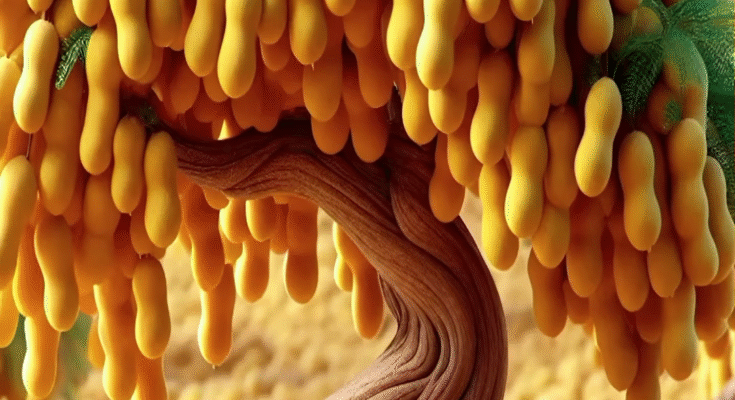Easy Method: How to Propagate and Grow Tamarind Fruit Trees
Tamarind (Tamarindus indica) is a tropical fruit tree known for its delicious sweet-sour pulp, which is used in cooking, drinks, and traditional medicine. Native to Africa but widely grown in Asia, especially in countries like India, Thailand, and Cambodia, tamarind is a hardy and long-living tree that can provide fruit for decades. If you want to grow tamarind trees at home or on a farm, the good news is that it’s easier than many people think. In this article, you’ll learn a simple, effective method to propagate and grow tamarind fruit trees successfully.
Step 1: Choosing the Right Tamarind Seeds
The easiest and most common way to propagate tamarind trees is by using seeds. Tamarind seeds are hard, brown, and glossy, and can be collected directly from ripe pods.
- Select mature pods: Pick fully ripened tamarind pods that have dried and turned brown. Remove the pulp and collect the seeds.
- Choose healthy seeds: Look for large, well-formed seeds with no signs of mold or damage.
While tamarind can also be grown from cuttings or grafting, seed propagation is much simpler for beginners and works well in most tropical and subtropical climates.
Step 2: Preparing the Seeds for Germination
Tamarind seeds have a hard outer shell that makes them slow to germinate unless pre-treated. Follow these easy steps to improve germination:
- Soak the seeds: Place the seeds in warm water and soak them for 24 to 48 hours. This softens the seed coat and helps the sprout emerge faster.
- Scarification (optional): You can speed up germination further by gently scratching the seed coat with sandpaper or a knife before soaking.
After soaking, the seeds should begin to swell, indicating that they are absorbing water and are ready to plant.
Step 3: Planting the Seeds
Now it’s time to plant your prepared seeds. You can either start them in pots or directly in the ground if conditions are suitable.
If using pots:
- Use small plastic pots or seedling trays with good drainage.
- Fill with well-draining soil, such as a mix of garden soil, sand, and compost.
- Plant the seeds about 1 inch deep.
- Water lightly, just enough to keep the soil moist but not soggy.
If planting directly in the ground:
- Choose a sunny spot with fertile, well-drained soil.
- Dig small holes about 1 inch deep and place the seeds inside.
- Cover with soil and water gently.
Seeds usually germinate within 1 to 3 weeks, depending on temperature and soil moisture.
Step 4: Caring for Young Tamarind Seedlings
Once the seeds sprout, proper care is essential to help them grow strong and healthy.
- Sunlight: Tamarind trees need full sun to thrive. Place your pots in a sunny location or ensure your garden spot gets at least 6–8 hours of sunlight daily.
- Watering: Keep the soil moist, especially during the seedling stage. Avoid overwatering, which can cause root rot.
- Fertilizing: Apply a light compost or organic fertilizer every 3–4 weeks to encourage strong growth.
- Thinning: If multiple seeds are planted in the same pot or area, thin them out to avoid overcrowding. Keep the strongest seedlings.
Within 2–3 months, your seedlings should reach 6–12 inches tall and be ready for transplanting if started in pots.
Step 5: Transplanting the Tamarind Tree
Tamarind trees grow large and need space. When your seedlings are strong enough, transplant them into their permanent spot.
- Timing: Transplant during the rainy season or in the early morning/evening to avoid heat stress.
- Spacing: Space trees at least 20–25 feet apart to give them room to spread.
- Hole preparation: Dig a hole twice as wide and deep as the root ball. Mix compost or well-rotted manure into the soil before planting.
- Water well: After transplanting, water the tree thoroughly to help it settle in.
Mulching around the base with straw or dry leaves helps retain soil moisture and control weeds.
Step 6: Ongoing Care and Maintenance
Tamarind trees are hardy and relatively low-maintenance once established, but a few practices will help them thrive and fruit sooner.
- Watering: Water regularly during dry periods, especially in the first 2–3 years.
- Fertilizing: Feed with organic compost or balanced NPK fertilizer 2–3 times a year.
- Pruning: Trim the lower branches during the early years to encourage upward growth and a strong central trunk.
- Pest and Disease Control: Tamarind trees are quite resistant but occasionally may face aphids, caterpillars, or fungal issues. Use neem oil or organic pest control if needed.
Step 7: Fruiting and Harvesting
Tamarind trees grown from seeds usually begin to bear fruit in 6 to 8 years. Grafted trees may start earlier, in about 3 to 4 years.
- Flowering: The tree produces small yellow flowers, which are followed by green pods that ripen to a brown color.
- Harvesting: Wait until the pods are fully brown and dry before harvesting. You can store the pulp or use it fresh.
Once mature, a single tree can produce hundreds of pods per season, making it a valuable long-term investment for your home garden or orchard.
Conclusion
Growing tamarind trees is easier than you might think, and with a little care and patience, you can enjoy a healthy, fruit-bearing tree for decades. By starting from seed, soaking for better germination, planting in good soil, and giving the right amount of water and sun, you can successfully propagate tamarind with very little cost. Whether for personal use or small-scale farming, this simple method offers a practical way to grow a tree that provides shade, beauty, and a bounty of delicious fruit.



